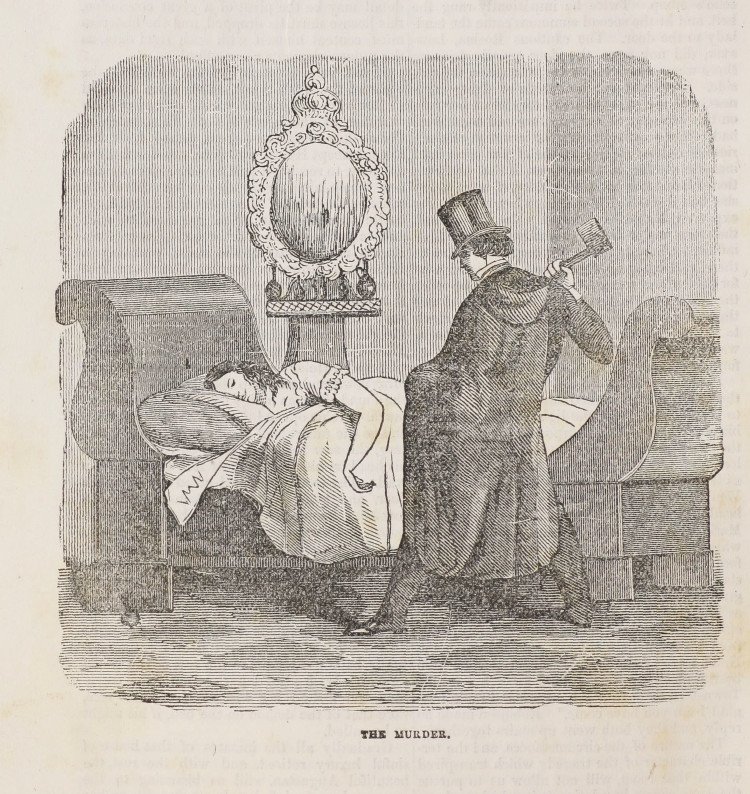True Crime: Media & the Murder of Helen Jewett
by Labonno Islam
This online exhibition builds off of a single image taken from a book (housed at the Library Company of Philadelphia) titled The Lives of Helen Jewett and Richard P. Robinson by George Wilkes who—according to the first page of the book—is the “Editor of the New York National Police Gazette.” The image appears on page 118 of the book (which was published in 1849) and is titled “THE MURDER.” This exhibition explores media sensation and consumption, particularly in relation to what one may define as “true crime” today. As someone who has always been drawn to the true crime genre, I was particularly interested in the narratives that journalism and newspapers created during their coverage of the murder and its case. People were captivated by the murder of Helen Jewett—showing that the fascination of true crime isn’t new—because of storytelling tactics used by the media.
Please note: The following artwork may contain images that are not suitable for all audiences. The images contain nudity and references to graphic violence that may be offensive or traumatizing to some viewers and may be inappropriate for persons under 18. The displayed pieces reflect the viewpoint of the credited artist(s) and do not necessarily reflect the viewpoints of Temple University.
LABEL
This illustration appears on page 118 of The Lives of Helen Jewett and Richard P. Robinson by George Wilkes. It depicts the murder of Helen Jewett, a New York City prostitute, in 1836 by a man, presumably a clerk named Richard P. Robinson, who was one of her clients. Helen Jewett’s brutal murder caused a media sensation. Newspapers published different versions of what happened and took advantage of the public’s interest in this case by claiming that their particular version was the accurate one. The coverage captured the public’s attention because both Jewett and Robinson didn’t fit into the stereotypical ideas about men and women in the 19th-century. Richard P. Robinson went on trial for the murder, but was acquitted.
COUNTERLABEL
From the words of a researcher and amateur true crime enthusiast: It’s 1849 and George Wilkes has written a “novel” that covers the life and brutal murder of Helen Jewett—a prostitute in New York City—and her former client and potential murderer, Richard P. Robinson. The Lives of Helen Jewett and Richard P. Robinson includes several images—including this one that appears on page 118 and is titled “THE MURDER.” In this illustration, Robinson holds a hatchet and hovers over a sleeping Jewett, likely ready to commit the infamous killing. Like the journalists who initially covered the case in 1836, Wilkes—the Editor of the New York National Police Gazette—has told a story about the murder. There’s no telling what’s necessarily true—which leaves us with a key question: why does the public need a good story?
“Helen Jewett at her Childhood’s Home” is the first illustration that appears in Wilke’s The Lives of Helen Jewett and Richard P. Robinson. When looking at this image, we see Helen as a young girl—her eyes wide and open, suggesting innocence. She seems to be watering the garden steps away from a house that has smoke coming out of its chimney. This picture paints an idyllic setting that invokes the traditional and pure woman. Opening the book with this image of an “uncorrupted” Jewett implies that she will go down a road of darkness—perhaps setting up for a cautionary tale for women.
Wilkins, George. Jewett, Helen, 1813-1836. Print. Library Company of Philadelphia. 1849. https://digital.librarycompany.org/islandora/object/digitool%3A35620?solr_nav%5Bid%5D=44f49cac12e877301a4e&solr_nav%5Bpage%5D=0&solr_nav%5Boffset%5D=0
This image is the title page for a version of Wilke’s The Lives of Helen Jewett and Richard P. Robinson. The version that I saw at the Library Company of Philadelphia doesn’t have this page. Intriguingly, this version was actually published in Philadelphia by T.B. Peterson & Brothers. The dripping bloody font adds a spooky, dramatic element. The snake that wraps around Jewett’s portrait suggests temptation and sin. In the block quote, the speaker wonders “how [the story’s] strange knowledge was collected by the author, or how he was enabled to methodize it so accurately in the hasty manner in which he must have prepared its weekly chapters for the Press.” There seems to be a question hiding in the shadows: how much of this is true? Once again, we’re reminded that only certain narratives will sell and ignite interest.
Peterson, T.B. Title Page. Online. World Trials Library. https://heinonline.org/HOL/P?h=hein.trials/xyet0001&i=1
When the murder case of Helen Jewett took over the press, many local artists shared portrayals of Jewett. Most of these pictures depicted Jewett murdered on her bed with parts of her body exposed. James Gordon Bennett printed the first account of the murder of Jewett in the tabloid he founded—the New York Herald. His description included the following phrases: “perfect figure—the exquisite limbs—the fine face—the full arms—the beautiful bust…” He also stated that her “beautiful female corpse…surpassed the finest statue in antiquity.” This particular artistic portrayal has made Helen (or Ellen as some newspapers printed) look statuesque. Her breasts are visible. She looks at peace in her slumber. Of course, none of this matches the violent scene of the murder. Instead, it creates an intriguing persona for the character of Jewett: beautiful and desirable.
Hoffy, Alfred M. Ellen Jewett. Online. American Antiquarian. 1836. https://www.americanantiquarian.org/Exhibitions/Beauty/ellen.jpg
It’s important to finally touch on Jewett’s alleged murderer: Richard P. Robinson. A brief article appeared in the New York Daily Times in 1855 that stated a report of Robinson’s death is untrue. This brief story shows the mythologization often linked with true crime stories. The name of the article (“The Murderer of Helen Jewett”) draws the reader’s attention through baiting context. The speculation about Robinson’s fate shows that there’s a continued fascination with the case and the people involved in it. The interest in stories like Helen Jewett’s murder continues today and the true crime genre continues to captivate present-day audiences. The media—including social media—plays a key role in continuing to foster this interest through coverage and online discussions.
"The Murderer of Helen Jewett." 1855. New York Daily Times (1851-1857), Aug 22, 4. http://libproxy.temple.edu/login?url=https://www.proquest.com/historical-newspapers/murderer-helen-jewett/docview/95878801/se-2
Podcast: The Story of Helen Jewett's Murder
Welcome to Historical True Crime! This brief podcast episode is inspired by an illustration found in a little old book titled The Lives of Helen Jewett and Richard P. Robinson.
Labonno Islam
Creative Writing, Fiction / 2024
Labonno is an MFA student at Temple University's Creative Writing program. Her focus in the program is fiction. Writing stories has been a part of Labonno's life for as long as she can remember. She's currently working on a novel (and hopes to one day finish it). She currently resides in Philadelphia. She (unsurprisingly) loves to read and has a stack of books on her dresser that are waiting to be opened.







